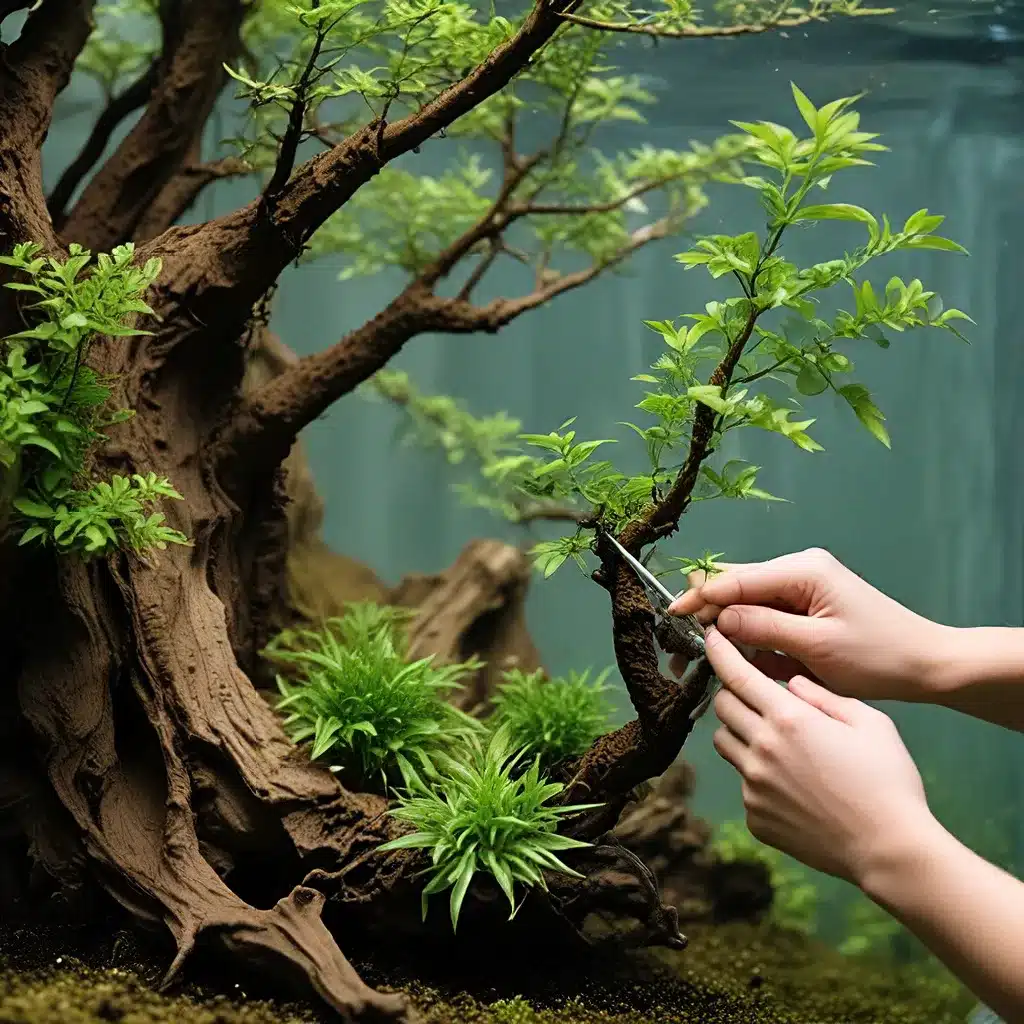
Understanding the Purpose of Aquarium Plant Pruning
Aquarium plant pruning is an essential aspect of aquascaping and maintaining the overall health and aesthetics of your planted tank. Proper pruning techniques allow you to shape and control the growth of your aquatic plants, ensuring they remain visually appealing and do not overpower the aquarium environment. By selectively trimming and shaping your plants, you can create stunning, nature-inspired layouts that showcase the unique forms and textures of your aquatic flora.
King Aquarium, a leading source for aquarium enthusiasts, emphasizes the importance of mastering plant pruning skills. “Aquarium plants are the backbone of any well-designed aquascape,” explains the site’s aquascaping expert. “Knowing how to prune them effectively is the key to maintaining that lush, cohesive look you envisioned for your tank.”
Assessing Your Aquarium Plants
Before you begin pruning, it’s essential to understand the specific growth patterns and care requirements of the plants in your aquarium. Different aquatic plant species have varying levels of robustness and tolerance to fish activity, water parameters, and other environmental factors. Some plants, like giant vallis and Amazon swords, are more resilient and can withstand the playful antics of active fish, while delicate, frondy plants may struggle to thrive in such conditions.
It’s important to research the unique characteristics of the plants in your tank and identify which ones require more frequent pruning or special consideration. For example, stem plants like hygrophila and ludwigia often require regular trimming to maintain their shape and prevent excessive overgrowth, while rhizome plants like java fern may only need occasional thinning.
Pruning Techniques for Aquarium Plants
Effective aquarium plant pruning involves a combination of fundamental techniques, each tailored to the specific needs of your aquatic flora. Here are some key pruning methods to consider:
Trimming and Shaping
Trimming is the most common pruning technique, where you use sharp scissors or aquascaping tools to selectively cut back the plants to your desired height and shape. This method is particularly useful for stem plants, as it encourages lateral growth and helps maintain a compact, well-defined appearance.
When trimming, be mindful to remove any damaged, discolored, or dying leaves or stems to prevent the spread of algae or disease. Cut just above a set of healthy leaves or nodes, ensuring the plant has the resources to regrow and maintain its form.
Thinning and Dividing
For plants that tend to grow in dense, bushy clusters, such as cryptocorynes or Amazon swords, thinning can be an effective pruning technique. Carefully remove select stems or leaves to open up the plant’s structure, allowing for better light penetration and water circulation.
In addition, dividing can be a useful strategy for managing the growth of rhizome plants or those that spread through runners. Carefully remove the plant from the substrate, separate the rhizome or runners into smaller sections, and replant them to encourage new growth and prevent overcrowding.
Selective Pruning
Some aquarium plants, like java fern and anubias, are best pruned through selective cutting. Instead of removing entire stems or leaves, you can carefully snip off individual damaged or unsightly portions, preserving the overall structure and health of the plant.
This targeted approach helps maintain the natural appearance of these types of plants, while also addressing any issues that may arise, such as algae growth or uneven development.
Timing and Frequency of Pruning
The optimal timing and frequency of aquarium plant pruning will depend on the specific needs of your aquarium’s ecosystem and the growth rate of your plants. As a general rule, it’s recommended to prune your plants every 2-4 weeks, or whenever you notice significant overgrowth or undesirable changes in their appearance.
Factors such as lighting, nutrient levels, and fish activity can all influence the rate of plant growth, so be prepared to adjust your pruning schedule accordingly.
When pruning, it’s essential to perform the task during your regular water changes or maintenance routine. This not only helps minimize the disruption to your aquarium’s ecosystem but also allows you to dispose of the trimmed plant matter properly and prevent it from contributing to water quality issues.
Incorporating Pruned Material into Your Aquascape
Rather than simply discarding the trimmed plant material, consider repurposing it to enhance your aquascape further. Aquarium enthusiasts often use pruned stems, leaves, or rhizome sections to create new planting areas, propagate existing plants, or even float them as decorative accents.
Replanting pruned material can be an effective way to fill in bare spots, create visual depth, and maintain the overall cohesiveness of your aquascape. When replanting, be sure to follow the appropriate techniques for the specific plant type, ensuring they are securely anchored and have access to the necessary nutrients and water flow.
Balancing Aquarium Plant Health and Aesthetics
Successful aquarium plant pruning requires a delicate balance between maintaining the health and vitality of your aquatic flora while also achieving your desired aesthetic goals. By carefully assessing the needs of your plants, employing the right pruning techniques, and timing your maintenance accordingly, you can create a thriving, visually stunning planted tank that will captivate both you and your aquarium’s inhabitants.
Remember, aquascaping is an ongoing process, and your pruning routine may need to evolve as your aquarium matures and your plants’ growth patterns change. Stay vigilant, experiment, and don’t be afraid to make adjustments – the rewards of a well-maintained, lush aquarium will be well worth the effort.

